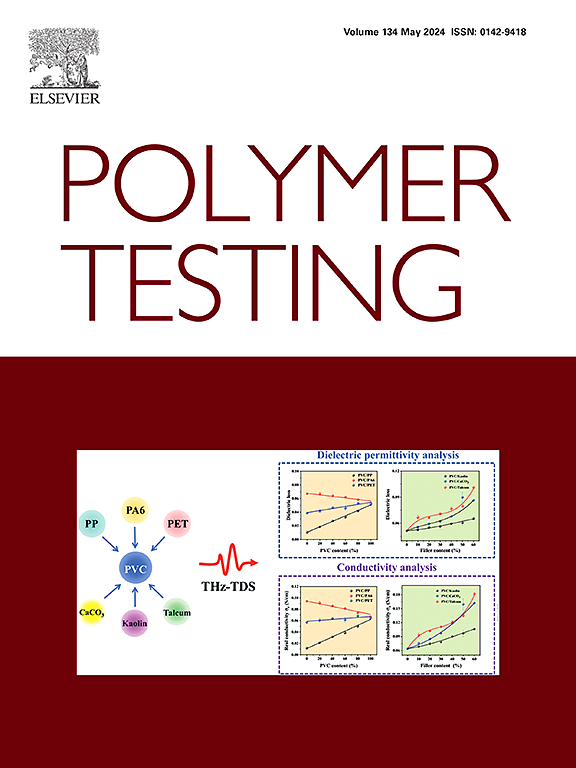Innovative methods lined up for qualification of waste elastomer fillers
IF 6
2区 材料科学
Q1 MATERIALS SCIENCE, CHARACTERIZATION & TESTING
引用次数: 0
Abstract
In the present paper the impacts of particle size of different waste elastomer fillers and homogenization time with the polymer matrix have been studied. Oscillatory rheometric tests have been conducted on EPDM-containing polyethylene, iGC measurements and SEM images have been investigated to understand the phenomena behind the mechanical properties. One of the practically useful outcomes have been the extension of LVE range of blends with the whole fraction of EPDM particles (0.00–1.25 mm) compared to larger particle domains, such as 0.40–0.63 mm; 0.63–1.00 mm and 1.00–1.25 mm; since the smaller particles increase the interfacial area favourable for stress transfer. The most influenced mechanical property was the elongation at break followed by the impact strength in w-EPDM blends but no other statistical correlation between the particle size distribution and the sample preparation method and the measured mechanical properties has been found for the other type filler containing blends. A relationship between the crossover frequency, i.e., ‘apparent molecular weight’ and homogeneity of the dispersion of waste EPDM particles containing polymers has been found and confirmed by the mechanical properties either. The relative apparent molecular weight, expressed in rad/s, determined from the intersection of G′ and G″ obtained through frequency sweep tests can be used to quantify the homogeneity related to the dispersion of polymer/waste elastomer blends with the same composition but different particle sizes.
对废弹性体填料进行鉴定的创新方法
本文研究了不同废弹性体填料的粒径和均质时间对聚合物基体的影响。对含epdm的聚乙烯进行了振荡流变试验,研究了iGC测量和SEM图像,以了解力学性能背后的现象。其中一个实际有用的结果是,与更大的颗粒域(如0.40-0.63 mm)相比,EPDM颗粒的整个分数(0.00-1.25 mm)的共混物的LVE范围得到了扩展;0.63-1.00 mm和1.00-1.25 mm;因为较小的颗粒增加了有利于应力传递的界面面积。在w-EPDM共混物中,对其力学性能影响最大的是断裂伸长率,其次是冲击强度,而在其他类型的含共混物中,粒径分布与样品制备方法之间没有其他统计相关性。发现了交叉频率,即“表观分子量”与含有聚合物的废旧EPDM颗粒分散的均匀性之间的关系,并通过机械性能证实了这一点。相对表观分子量(以rad/s表示)由频率扫描试验得到的G′和G″的交集确定,可用于量化具有相同组成但不同粒径的聚合物/废弹性体共混物与分散相关的均匀性。
本文章由计算机程序翻译,如有差异,请以英文原文为准。
求助全文
约1分钟内获得全文
求助全文
来源期刊

Polymer Testing
工程技术-材料科学:表征与测试
CiteScore
10.70
自引率
5.90%
发文量
328
审稿时长
44 days
期刊介绍:
Polymer Testing focuses on the testing, analysis and characterization of polymer materials, including both synthetic and natural or biobased polymers. Novel testing methods and the testing of novel polymeric materials in bulk, solution and dispersion is covered. In addition, we welcome the submission of the testing of polymeric materials for a wide range of applications and industrial products as well as nanoscale characterization.
The scope includes but is not limited to the following main topics:
Novel testing methods and Chemical analysis
• mechanical, thermal, electrical, chemical, imaging, spectroscopy, scattering and rheology
Physical properties and behaviour of novel polymer systems
• nanoscale properties, morphology, transport properties
Degradation and recycling of polymeric materials when combined with novel testing or characterization methods
• degradation, biodegradation, ageing and fire retardancy
Modelling and Simulation work will be only considered when it is linked to new or previously published experimental results.
 求助内容:
求助内容: 应助结果提醒方式:
应助结果提醒方式:


